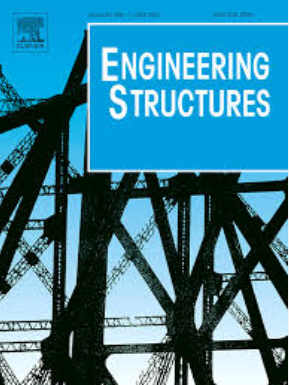Hybrid retrofitting for upgrading the seismic performance of adjacent bridges vulnerable to different damage modes including pounding
IF 5.6
1区 工程技术
Q1 ENGINEERING, CIVIL
引用次数: 0
Abstract
Earthquake-induced damage, such as pounding, has emphasized the vulnerability of existing bridges, underscoring the essential requirement for retrofitting. This study thus aims to select hybrid retrofit strategies for upgrading the seismic performance of reinforced concrete substandard bridges vulnerable to various damage modes to ensure the safety and serviceability of existing bridges. The study proposes implementing steel dampers to reduce bearing displacement (BD), innovative rubber bumpers in separation gaps to alleviate structural pounding between adjacent bridges, and ultra-high-performance concrete (UHPC) jackets and self-centering buckling restrained braces (SC-BRB) to mitigate curvature ductility (CD) demands of bridge substructure. The idealization of the adopted mitigation measures is verified by comparing their fiber-based numerical models with the hysteretic behavior observed from previous experimental studies. The numerically validated retrofit strategies are then applied to existing benchmark adjacent bridges commonly prevailing in a medium seismicity study area. The adjacent bridges’ dynamic characteristics and lateral capacity are initially investigated to evaluate the retrofit options by monitoring various local damage indices. Fragility analyses are conducted under different seismic scenarios to assess the relative performance of the adopted retrofit schemes and to evaluate the likelihood of exceeding the seismic capacity of the retrofitted bridge structure. Although the probabilistic assessment study indicated that the UHPC and SC-BRB retrofit options enhanced the bridges’ lateral capacity by a comparable ratio of 53 %, the adopted seismic performance-cost indicator of SC-BRB retrofit measure exceeded that of the UHPC alternative by 39 %-79 %, confirming its preference among the considered two alternatives. The steel dampers effectively reduce BD demands, whereas rubber bumpers adequately decrease pounding force demands. This study thus offers insights into the effects of integrating the adopted seismic risk mitigation techniques into an effective and economical hybrid retrofit measure to mitigate the vulnerability of substandard adjacent bridges, thereby ensuring their functionality post-earthquake.
求助全文
约1分钟内获得全文
求助全文
来源期刊

Engineering Structures
工程技术-工程:土木
CiteScore
10.20
自引率
14.50%
发文量
1385
审稿时长
67 days
期刊介绍:
Engineering Structures provides a forum for a broad blend of scientific and technical papers to reflect the evolving needs of the structural engineering and structural mechanics communities. Particularly welcome are contributions dealing with applications of structural engineering and mechanics principles in all areas of technology. The journal aspires to a broad and integrated coverage of the effects of dynamic loadings and of the modelling techniques whereby the structural response to these loadings may be computed.
The scope of Engineering Structures encompasses, but is not restricted to, the following areas: infrastructure engineering; earthquake engineering; structure-fluid-soil interaction; wind engineering; fire engineering; blast engineering; structural reliability/stability; life assessment/integrity; structural health monitoring; multi-hazard engineering; structural dynamics; optimization; expert systems; experimental modelling; performance-based design; multiscale analysis; value engineering.
Topics of interest include: tall buildings; innovative structures; environmentally responsive structures; bridges; stadiums; commercial and public buildings; transmission towers; television and telecommunication masts; foldable structures; cooling towers; plates and shells; suspension structures; protective structures; smart structures; nuclear reactors; dams; pressure vessels; pipelines; tunnels.
Engineering Structures also publishes review articles, short communications and discussions, book reviews, and a diary on international events related to any aspect of structural engineering.
 求助内容:
求助内容: 应助结果提醒方式:
应助结果提醒方式:


